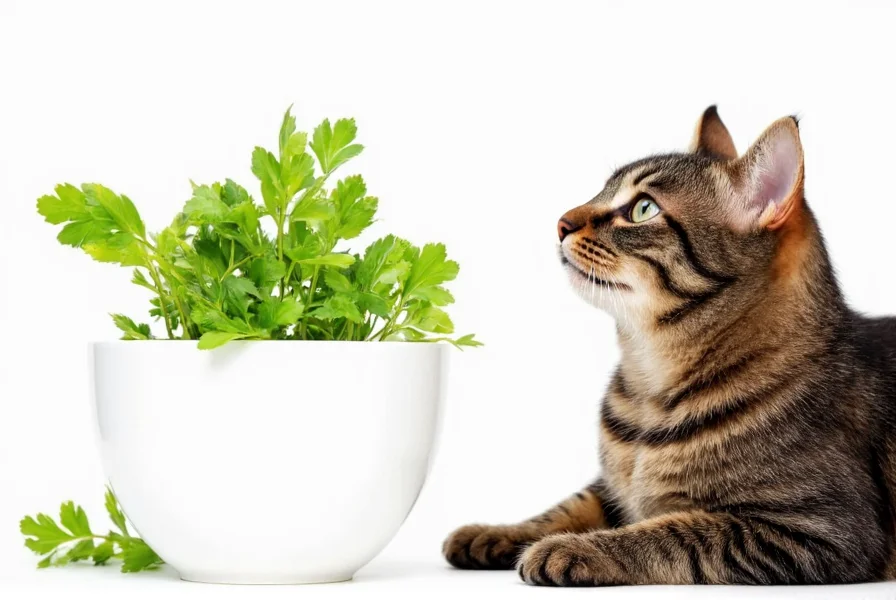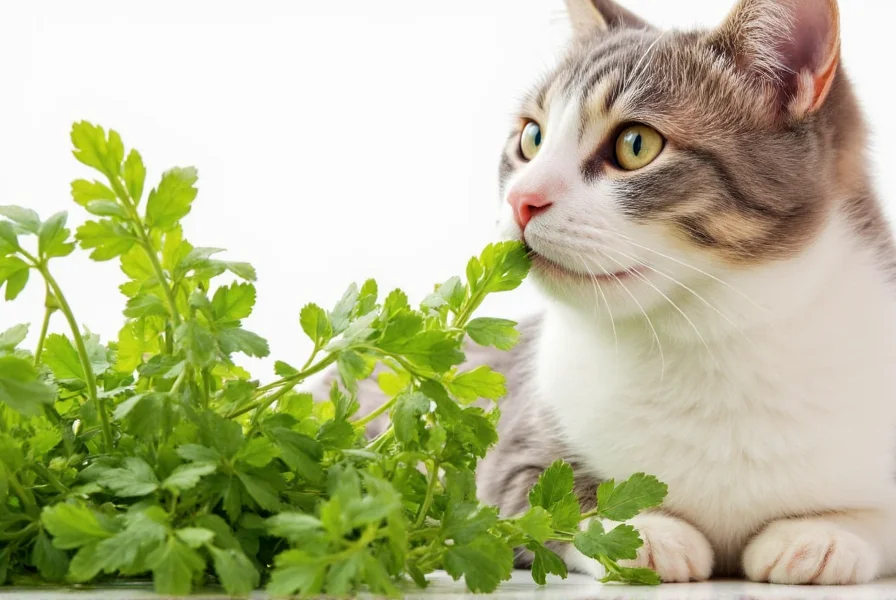Many cat owners wonder about sharing human foods with their feline companions, especially when they catch their curious kitty nibbling on kitchen herbs. Coriander, with its distinctive flavor and widespread use in cooking, often raises questions about feline safety. Understanding which human foods are appropriate for cats is crucial for responsible pet ownership, as cats have unique digestive systems that process foods differently than humans.
Coriander vs. Cilantro: Understanding the Terminology
The terms "coriander" and "cilantro" refer to different parts of the same plant (Coriandrum sativum). In North America, "cilantro" typically describes the fresh leaves and stems, while "coriander" refers to the dried seeds. Internationally, "coriander" often encompasses the entire plant. When discussing can cats eat coriander leaves, we're referring to the fresh green portion commonly called cilantro in the United States.
Scientific Perspective on Coriander Safety for Cats
According to veterinary toxicology resources, coriander contains no compounds known to be toxic to cats. Unlike plants such as lilies, which are highly dangerous to felines, coriander lacks harmful substances that would cause organ damage or systemic toxicity. The ASPCA lists coriander as non-toxic for cats, confirming that coriander toxicity in cats is not a documented concern.
While cats are obligate carnivores requiring meat-based diets, small amounts of certain plants can be safely consumed. Coriander contains vitamins A, C, and K, along with antioxidants, though cats derive minimal nutritional benefit from these as they produce vitamin C internally and have different vitamin requirements than humans.
| Herb | Cat Safety Status | Notes |
|---|---|---|
| Coriander/Cilantro | Non-toxic | Safe in small amounts; no known toxic compounds |
| Catnip | Non-toxic | Causes temporary behavioral effects in 50-70% of cats |
| Basil | Non-toxic | Generally safe but may cause mild digestive upset |
| Garlic | Highly toxic | Causes hemolytic anemia; never feed to cats |
| Onion | Highly toxic | Damages red blood cells; avoid all forms |
Potential Benefits of Coriander for Cats
While not nutritionally essential, coriander may offer some mild benefits when given occasionally:
- Digestive support: The herb contains compounds that might help soothe minor digestive discomfort in some cats
- Antioxidant properties: May provide mild cellular protection, though cats have different antioxidant needs than humans
- Mental stimulation: The novel scent and texture can provide environmental enrichment for curious cats
- Hydration boost: Fresh coriander contains moisture, which can supplement water intake for cats that don't drink enough
Appropriate Serving Guidelines for Cats
When offering coriander to your feline friend, follow these safety guidelines:
- Portion size: Limit to 1-2 small leaves (approximately 1/4 teaspoon chopped) per serving
- Frequency: No more than once or twice weekly as an occasional treat
- Preparation: Wash thoroughly to remove pesticides; offer fresh rather than cooked with seasonings
- Monitoring: Watch for any signs of digestive upset after first introduction
Remember that how much coriander can cats eat depends on your cat's size and individual tolerance. Larger cats might handle slightly more, but moderation remains key. Never force your cat to eat coriander if they show no interest.
When Coriander Might Cause Concern
While generally safe, certain situations warrant caution with coriander:
- Kittens under 6 months: Their digestive systems are still developing; stick to formulated kitten food
- Cats with kidney disease: Consult your veterinarian before introducing any new foods
- Pesticide exposure: Non-organic coriander may contain harmful chemical residues
- Excessive consumption: Large amounts might cause temporary digestive upset like vomiting or diarrhea
If your cat has consumed a large quantity of coriander, monitor for symptoms like excessive drooling, vomiting, or lethargy. While coriander toxicity in cats is extremely unlikely, individual sensitivities can occur.
Safely Introducing Coriander to Your Cat
Follow these steps when offering coriander for the first time:
- Wash the herb thoroughly under running water
- Remove any discolored or wilted leaves
- Chop one small leaf into tiny pieces
- Mix a pinch with your cat's regular food or offer separately
- Observe for 24 hours for any adverse reactions
- If well-tolerated, you can occasionally repeat in small amounts
Some cats show immediate interest in coriander's scent, while others couldn't care less. Never force your cat to eat something they reject—it's perfectly normal for cats to have individual food preferences.
Other Cat-Safe Herbs to Consider
If your feline enjoys coriander, they might also appreciate these safe alternatives:
- Cat grass (wheatgrass or oat grass): Specifically grown for cats and aids digestion
- Catnip (Nepeta cataria): Causes temporary euphoria in sensitive cats
- Valerian root: Similar effects to catnip for some cats
- Blueberry (in tiny amounts): Provides antioxidants
Always research what herbs can cats eat before offering anything new. Many common kitchen herbs like chives, garlic, and leeks belong to the allium family and are highly toxic to cats.
When to Consult Your Veterinarian
Contact your vet if your cat shows any of these symptoms after eating coriander:
- Persistent vomiting or diarrhea lasting more than 12 hours
- Signs of abdominal pain (hunched posture, reluctance to move)
- Excessive drooling or difficulty breathing
- Lethargy lasting more than 24 hours
- Refusal to eat regular food for more than one meal
While is coriander safe for cats generally has a positive answer, your veterinarian can provide personalized advice based on your cat's specific health profile and dietary needs.
Final Considerations for Cat Owners
Coriander can be a safe, occasional treat for cats when offered in appropriate amounts. However, it should never replace balanced commercial cat food that meets all their nutritional requirements. Cats need specific nutrients like taurine, arachidonic acid, and vitamin A that they can only obtain from animal-based sources.
When wondering can cats eat cilantro leaves, remember that moderation is key. Most cats won't seek out coriander regularly, but those that do can enjoy it safely as an occasional novelty. Always prioritize your cat's primary nutrition and consult your veterinarian before making any significant changes to their diet.

Frequently Asked Questions
Can cats eat coriander every day?
No, cats should not eat coriander daily. While non-toxic, it offers minimal nutritional value for cats. Limit coriander to once or twice weekly in very small amounts (1-2 small leaves) as an occasional treat, not a dietary staple.
Is cilantro the same as coriander for cats?
Yes, cilantro and coriander come from the same plant (Coriandrum sativum). In North America, "cilantro" refers to the fresh leaves while "coriander" typically means the seeds. Both forms are non-toxic to cats, though cats usually encounter the leafy cilantro portion.
What should I do if my cat ate a large amount of coriander?
If your cat consumed an unusually large amount of coriander, monitor for vomiting, diarrhea, or lethargy. While coriander isn't toxic, excessive amounts might cause temporary digestive upset. Contact your veterinarian if symptoms persist beyond 12 hours or appear severe.
Can kittens eat coriander?
It's best to avoid giving coriander to kittens under six months old. Their digestive systems are still developing, and they require complete nutrition from specially formulated kitten food. Wait until your cat is fully grown before introducing any non-essential foods like coriander.
Why do some cats like coriander while others ignore it?
Cats have individual taste preferences influenced by genetics and early experiences. Some cats are attracted to coriander's scent due to certain compounds that may mildly stimulate their olfactory receptors, while others find it uninteresting. This variation in response is completely normal among felines.











 浙公网安备
33010002000092号
浙公网安备
33010002000092号 浙B2-20120091-4
浙B2-20120091-4